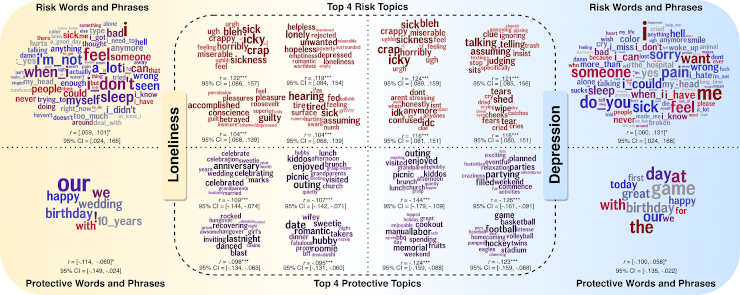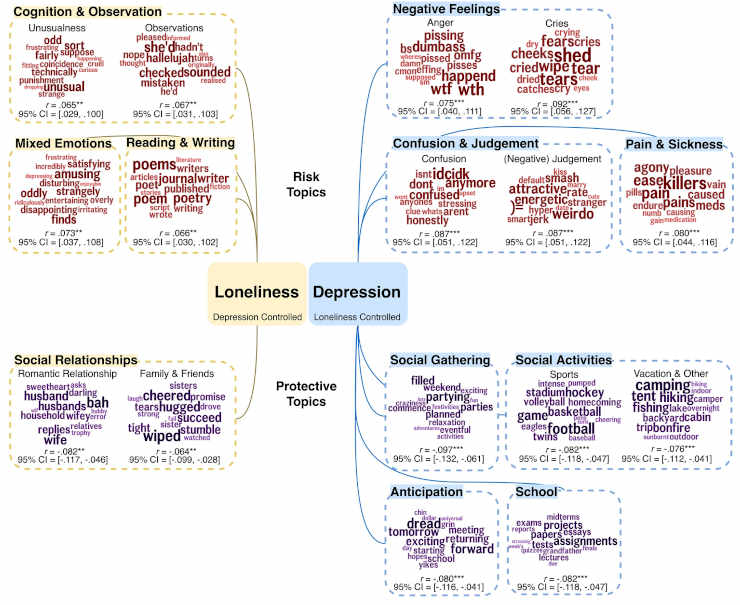Loneliness can be a symptom of depression as well as a risk factor. When working with people who have both problems, mental health professionals have to figure out how the two problems relate to each other while also recognizing and treating each problem on its own.
Both the general public and those with mental health disorders experience loneliness on a regular basis. Depression is characterized by protracted melancholy, irregular eating and sleeping patterns, and anhedonia. Loneliness and depression are highly correlated with one another.
Psychology needs to distinguish the distinctive characteristics of loneliness from depression in order to create interventions that are specifically designed to reduce loneliness.
A collaboration between the University of Pennsylvania, Purdue, Stanford, and the National Institute on Drug Abuse (NIDA) combines traditional psychological tests with linguistic techniques and machine-learning analysis of Facebook posts to shed light on the problem.
The Penn research team, led by computer scientist Sharath Guntuku and psychologist Tingting Liu, found that language related to loneliness is more focused on thinking than language related to depression. The frequent use of language that alludes to illness, pain, and negative emotions is another similarity between the two.
Social Media Language – A Wealth Of Linguistic Data

According to co-author Lyle Ungar, a professor of computer and information science and psychology in the School of Arts & Sciences, posts on social media sites like Facebook offer a wealth of linguistic data because users can freely choose the words they use to describe their thoughts and emotions. Their language on Facebook reveals a lot about their emotional states.
Informed consent was given for the researchers to compile 3.4 million Facebook posts from 2,986 social media users in order to find out how loneliness and depression are linked. Posts were extracted using the Facebook Graph API.
Then, in order to measure psychological state and feelings of social isolation, surveys on depression and loneliness were given out, consisting of questions from the 3-item UCLA loneliness scale and the Patient Health Questionnaire-9.
Lastly, they looked at how the Facebook posts were written to find words, phrases, or themes that were related to depression and loneliness.
Word Counts And Machine Learning
The researchers used a database created by University of Texas psychologists to categorize words based on their meaning and grammatical function. This is known as a linguistic inquiry word count or a closed-vocabulary, dictionary-based method.
Another method, known as the open-vocabulary method, used machine learning to extract frequent words, phrases, and subjects from posts made by depressed or lonely people.

The researchers discovered that persons who were depressed or lonely were more likely to use vocabulary concerning sickness, pain, and negative feelings, such as “crappy,” “miserable,” and “tired.” Those who were neither unhappy or lonely used words like “celebrated,” “date,” and “game.” to describe social gatherings, relationships, and positive emotions.
This pattern held for words with overtly emotional connotations, such as “bad” or “exciting,” as well as for words with more implicit meanings. For instance, depressed and lonely people frequently used the singular first-person pronoun “I,” whereas those who weren’t depressed or lonely frequently used the plural first-person pronoun “we,” which suggests a social relationship.
Head Or Heart
The two sets of words had some linguistic indicators in common, but they also had separate elements.
“We use ‘head versus heart’ to refer to this difference,”
lead author Liu said.
The language of depression involved more feelings, or the “heart,” and the language of loneliness involved more thoughts, or the “head,” the researchers discovered after controlling for both loneliness and depression individually.
Lonely persons referred to contemplative hobbies such as reading, writing, and observing the world more frequently, whereas sad people pointed to their apathy, suffering, and perplexity. These trends were also observed in common Internet acronyms and emoticons, with sad persons frequently utilizing the frowning “=(” emoticon and acronyms such as “idc” (short for “I don’t care”).
According to Liu, these findings imply that loneliness may have an internal cognitive component in addition to isolation or a lack of social skills.
“Loneliness could be driven by people’s perception of the environment and the social threats within,”
she said. This view supports previous research, too, which has found that strategies that target people’s dysfunctional social cognition are more successful than research that only examines social skills.
In addition to informing how therapists address loneliness and depression, the researchers say they hope their work can guide how social media platforms monitor for mental health risks and respond to mental health crises sooner.
Reference:
Liu, T., Ungar, L.H., Curtis, B. et al. Head versus heart: social media reveals differential language of loneliness from depression. npj Mental Health Res 1, 16 (2022).
Last Updated on November 11, 2023
